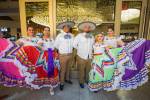Cultural influences transform interiors, architecture
Like most East Coast interior designers trained prior to the advent of globalism, I once could not imagine design and architecture based on a cultural tradition other than Europe's. There was always a single exception, however -- Japan. Its elegant design has been influencing American tastes since the start of the 20th century.
The narrowness of my outlook became obvious the first time I visited Mexico. The colors, shapes, textiles and ceramics I saw there had the impact of a revelation. Mexican interiors were amazing.
I've returned to that sun-soaked country many times and have read several books on Mexican design. One of the best was published not long ago by Stewart, Tabori & Chang. It's called "Casa Mexicana Style" and features magnificent photos by Tim Street-Porter and explanatory text by Annie Kelly.
Q: We've just finished building a connection from our house to my husband's painting studio. This passageway is wide enough to permit display of some artworks. It's got a high ceiling with a skylight, but it's also quite long.
Lighting will have to be added, I know, but first we've got to choose colors and wall coverings. Our aim is to create something a lot more attractive than a mere corridor.
A: Your choices can indeed make the passageway an exciting, three-dimensional work of art. But it's too bad you waited until so late in the process to decide on color and lighting. Because no design elements are more important than these, they should be part of a project plan right from the start.
The accompanying photo from "Casa Mexicana Style" shows what's possible in a space such as the one you describe. A tall ceiling made this passageway to a bedroom appear much longer and narrower than is currently the case.
Mexican architect Manolo Mestre added the wooden beams, which lowered the ceiling, thereby visually foreshortening the space and creating an illusion of greater width. He also enlivened the bland architecture by painting the end wall in a bright accent color and by placing a painting and a small sculpture there as well. The result is a further foreshortening of what was originally a tunnel-like space.
The various shades of orange, red, watermelon and brown comprise a distinctively Mexican color scheme with considerable visual appeal. Everything is nicely accentuated by the directional lighting installed above the beams.
I'm not suggesting that you should look to Mexico for inspiration, though that's certainly an appropriate direction to go -- especially, perhaps, for homes in the American Southwest. My main point is to encourage you -- and everyone else -- to consider alternatives to European-style design.
Rita St. Clair is a syndicated columnist with Tribune Media Services Inc. E-mail general interior design questions to her at rsca@ritastclair.com.























